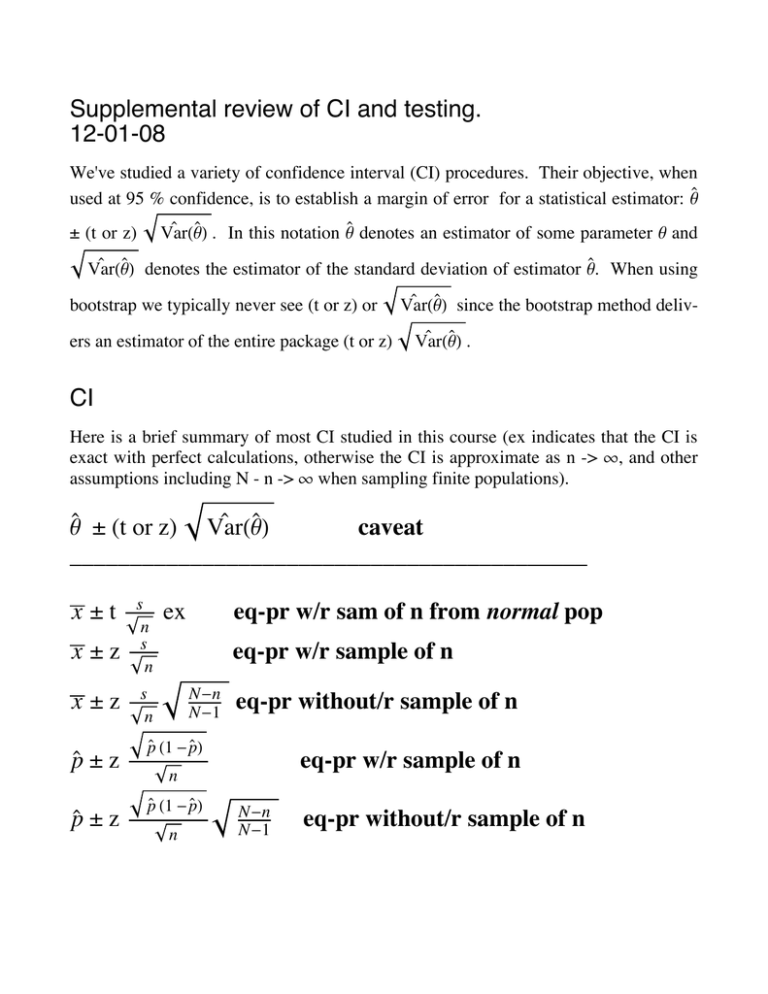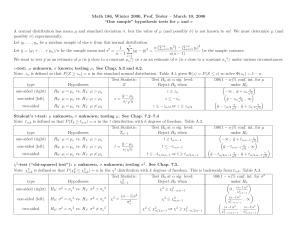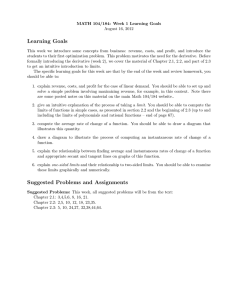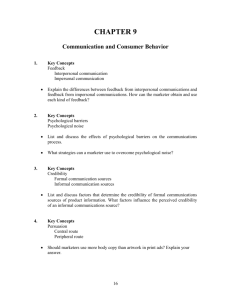Supplemental review of CI and testing. 12-01-08
advertisement

Supplemental review of CI and testing.
12-01-08
We've studied a variety of confidence interval (CI) procedures. Their objective, when
`
used at 95 % confidence, is to establish a margin of error for a statistical estimator: q
`
`
± (t or z) VarHq̀L . In this notation q denotes an estimator of some parameter q and
`
`
VarHq̀L denotes the estimator of the standard deviation of estimator q. When using
`
bootstrap we typically never see (t or z) or VarHq̀L since the bootstrap method deliv`
ers an estimator of the entire package (t or z) VarHq̀L .
CI
Here is a brief summary of most CI studied in this course (ex indicates that the CI is
exact with perfect calculations, otherwise the CI is approximate as n -> ¶, and other
assumptions including N - n -> ¶ when sampling finite populations).
`
`
q ± (t or z) VarHq̀L
caveat
___________________________________________
x±t
x±z
x±z
p` ± z
s
n
s
n
ex
eq-pr w/r sam of n from normal pop
eq-pr w/r sample of n
s
N-n
N-1
n
`
`
p H1 -pL
p` ± z
eq-pr without/r sample of n
eq-pr w/r sample of n
n
`
`
p H1 -pL
N-n
N-1
n
x-y ± z
p`x - p`y ± z
s2x
nx
+
eq-pr without/r sample of n
s2y
ny
`
`
px H1-pxL
nx
indep x, y sam, eq-pr, w/r
+
`
`
pyH1-pyL
ny
same as just above
p` ± z
p` ± z
2
eq-pr w/r sample of n
n
`
`
p H1 -pL
review12-01-08.nb
N-n
N-1
n
s2x
nx
x-y ± z
+
s2y
ny
`
`
px H1-pxL
nx
p`x - p`y ± z
eq-pr without/r sample of n
indep x, y sam, eq-pr, w/r
+
`
`
pyH1-pyL
ny
same as just above
`
`
q ± 95-th (or other) percentile of †q* - q† as approp
x±z
p` ± z
⁄Ki=1Wi s2i
prop'l eq-pr w/r strat sam
n
`
`
⁄Ki=1Wi pi H1-piL
n
`
sy
` )±
sx
prop'l eq-pr w/r strat sam
s
(y + (x-mx) r
z y 1 - r2 eq-pr w/r prs (x, y)
n
`
n-1
bi ± z Hi, iL entry of Hxtr xL-1 n-d
s@residD2 with { ei}
`
b = PseudoInverse[x].y
`y = x.b`
resid = y - y`
ind N(0, s2)
Tests from CI
Here is a brief description of how CI may be used to test hypotheses of the kind studied in tis course. The idea is a simple one. A CI is trying to locate (cover) a parameter q. If it is a 95% CI then P(CI covers q) ~ 0.95. So P(CI misses q) ~ 1 - 0.95 =
0.05. If could devise a test of (for example) the null hypothesis that q = 17 versus the
two-sided alternative hypothesis q ≠ 17 which
rejects H0 : q = 17 if CI fails to cover 17.
If truly q = 17 such a test commits type I error precisely when CI fails to cover 17.
This has probability 0.05 as above. So a = 0.05 for such a use of CI to test.
If, instead, we wish to perform a one-sided test
H0: q = 17 versus Ha: q > 17
we could harness the CI in the following way:
reject H0 if CI falls entirely to the right of 17.
For this test, a = (1-0.95)/2 = 0.025 since the 0.05 probability of having the CI fail to
two-sided alternative hypothesis q ≠ 17 which
rejects H0 : q = 17 if CI fails to cover 17.
If truly q = 17 such a test commits type I error precisely when CI failsreview12-01-08.nb
to cover 17.3
This has probability 0.05 as above. So a = 0.05 for such a use of CI to test.
If, instead, we wish to perform a one-sided test
H0: q = 17 versus Ha: q > 17
we could harness the CI in the following way:
reject H0 if CI falls entirely to the right of 17.
For this test, a = (1-0.95)/2 = 0.025 since the 0.05 probability of having the CI fail to
cover 17 is about equally divided between missing to the left or missing to the right.
Testing
H0: q = 17 versus Ha: q < 17
we would
reject H0 if CI falls entirely to the left of 17.
Once again, a = 0.025.
0 - 1 data and tests
We might make a test for
H0: p = 0.1 versus Ha: p ≠ 0.1
by
`
rejecting H0 if CI p ± z
`
`
p I1 -pM
n
fails to cover 0.1.
Then a ~ 0.05. but that is not the preferred test. If p = 0.1 then the population sd is
`
`
0.1 µ 0.9 and need not be estimated by p H1 - pL . The preferred test
`
rejects H0 if p ± z 0.1 µ 0.9 fails to cover 0.1.
n
Two points:
a. The preferred test looks like it uses a CI, but does not.
b. The preferred test more closely achieves a ~ 0.05.
The one-sided counterpart
H0: p = 0.1 versus Ha: p > 0.1
`
reject H0 if p ± z 0.1 µ 0.9 falls entirely right of 0.1
n
is preferred over the CI test as well. It more accurately achieves a ~ 0.025 than does
the one-sided CI test.
Comments.
z, t may take values other than 1.96, or the t-values related to 95% confidence. As
pertains to using 99% CI to z-test we have
a ~ 1 - 0.99 = 0.01 in two-sided test
a ~ (1 - 0.99) / 2 = 0.005 in one-sided test.
the one-sided CI test.
Comments.
review12-01-08.nb
4
z, t may take values other than 1.96, or the t-values related to 95% confidence. As
pertains to using 99% CI to z-test we have
a ~ 1 - 0.99 = 0.01 in two-sided test
a ~ (1 - 0.99) / 2 = 0.005 in one-sided test.
As for b, we limit ourselves to the types of plots and table uses found on exam 3.
Any of the CI can be used to test in the way just outlined.







